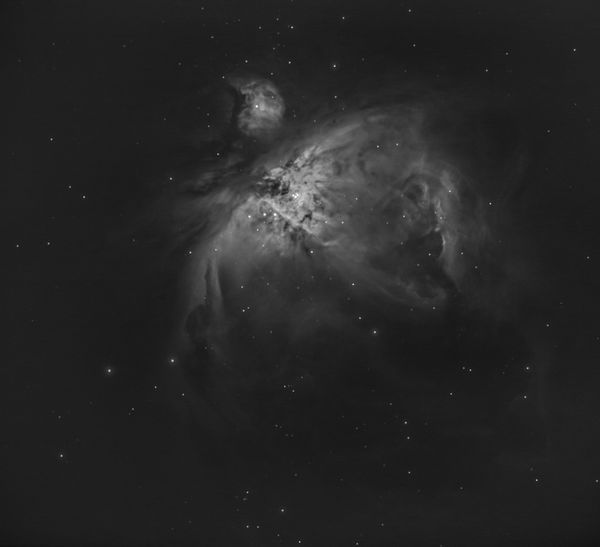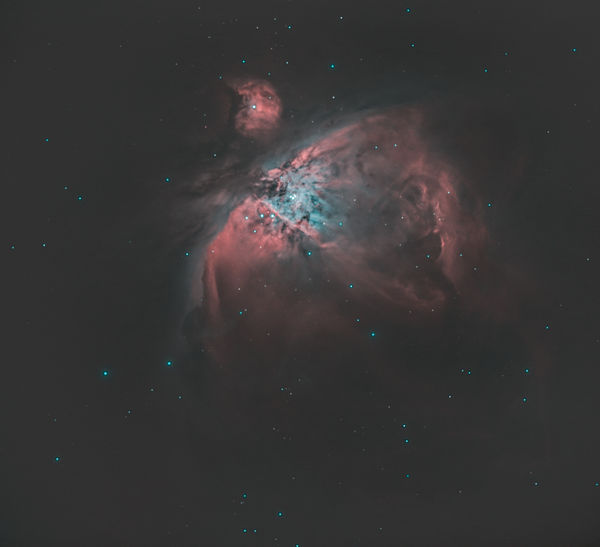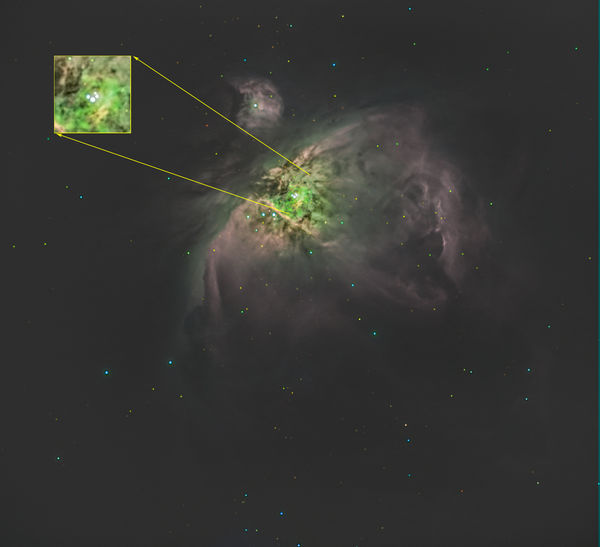Orion Trapezium Star Cluster thru scattered cloud
Jan 2, 2019 19:26:43 #
The sky was totally crappy last night with fast moving scattered cloud but it was a balmy +12C with only a somewhat annoying Chinook wind BUT too nice a night to sit in the house.
I decided to go after the Orion Trapezium Star Cluster with a QHY 163M camera, Optolong filters and Sky-Watcher 190 Mak-Newt on a Celestron CGEM-DX mount. I shot 4 sec. subs, 2x2 binned, for all session but varied the Gain to give the best histogram results.
The cloud was a continual problem throughout the night with about 75% of the subs discarded!!
The last image can be Downloaded for the full detail of the Trapezium Cluster. The region around the Trapezium has very good Oiii (ionized Oxygen) response.
"The Trapezium or Orion Trapezium Cluster is a tight open cluster of stars in the heart of the Orion Nebula. Galileo Galilei discovered three of the stars in 1617. A fourth star was identified by several observers in 1673 and several more components were discovered later for a total of eight by 1888. Subsequently several of the stars were determined to be binaries.
The Trapezium is a relatively young cluster that has formed directly out of the parent nebula. The five brightest stars are on the order of 15-30 solar masses in size. They are within a diameter of 1.5 light-years of each other and are responsible for much of the illumination of the Orion nebula. The Trapezium may be a sub-component of the larger Orion Nebula Cluster, a grouping of about 2,000 stars within a diameter of 20 light-years."
Enjoy!
bwa
I decided to go after the Orion Trapezium Star Cluster with a QHY 163M camera, Optolong filters and Sky-Watcher 190 Mak-Newt on a Celestron CGEM-DX mount. I shot 4 sec. subs, 2x2 binned, for all session but varied the Gain to give the best histogram results.
The cloud was a continual problem throughout the night with about 75% of the subs discarded!!
The last image can be Downloaded for the full detail of the Trapezium Cluster. The region around the Trapezium has very good Oiii (ionized Oxygen) response.
"The Trapezium or Orion Trapezium Cluster is a tight open cluster of stars in the heart of the Orion Nebula. Galileo Galilei discovered three of the stars in 1617. A fourth star was identified by several observers in 1673 and several more components were discovered later for a total of eight by 1888. Subsequently several of the stars were determined to be binaries.
The Trapezium is a relatively young cluster that has formed directly out of the parent nebula. The five brightest stars are on the order of 15-30 solar masses in size. They are within a diameter of 1.5 light-years of each other and are responsible for much of the illumination of the Orion nebula. The Trapezium may be a sub-component of the larger Orion Nebula Cluster, a grouping of about 2,000 stars within a diameter of 20 light-years."
Enjoy!
bwa
M42(77x4sec.,2x2binned)_LR_Ha_ABE_LR

M42(77x4sec.,39x4sec.,2x2binned)_LR_HaHaOiiiOiii_MStretch_ABE_LR

M42(77x4sec.,~30x4sec.,2x2binned)_LR_HaRGB_ABE_LR_PS w/ Insert

(Download)
Jan 3, 2019 09:36:29 #
bwana wrote:
The sky was totally crappy last night with fast mo... (show quote)
That's still one of my favorite subjects. I finally got a decent image of the Trapezium when I had a C14 and was able to get what I thought was 9, but maybe it was wishful thinking on my part.
Jan 3, 2019 09:48:19 #
bwana wrote:
The sky was totally crappy last night with fast mo... (show quote)
Considering your bad skies and the fact it must be lower in the sky at your latitude, you have captured it extremely well. I've not used your filter combination, but might try it sometime. I really like the Mak-Newtonian performance better than the SCT.
Jan 3, 2019 16:40:54 #
alberio wrote:
Considering your bad skies and the fact it must be lower in the sky at your latitude, you have captured it extremely well. I've not used your filter combination, but might try it sometime. I really like the Mak-Newtonian performance better than the SCT.
I had an 11" SCT at one point but never really got into using it for astro-imaging but used it for a couple of years for visual astronomy until I got tired of colorless 'blobs'! It was also a heavy beast.
I also have an Celestron 8" EdgeHD but find the 190 Mak-Newt to be the far superior scope for imaging, at least with my KISS approach to imaging, i.e.: unguided. But the 8" with a 2x PowerMate is nice for planetary imaging (whenever my skies allow; not often on the eastern slopes of Rockies!).
bwa
Jan 3, 2019 17:04:27 #
bwana wrote:
I had an 11" SCT at one point but never reall... (show quote)
The C11 with the HyperStar III is a lot of fun. Pinpoint stars, widefield and lots of aperture.
At f2 it is incredibly fast and rarely needs guiding. I sold mine years ago wanting to try something different. Now I'm going back to that combo. If I want to do planetary imaging, I just reconfigure to f20 or more. Damian Peach has taken some of the best images of the planets using the C14. You are right, you need steady skies.
Jan 7, 2019 05:02:43 #
Jan 15, 2019 08:52:41 #
If you want to reply, then register here. Registration is free and your account is created instantly, so you can post right away.


